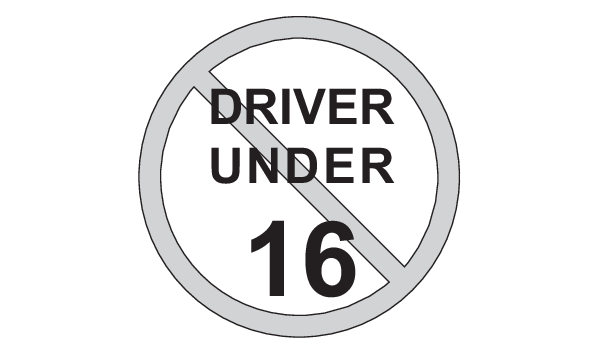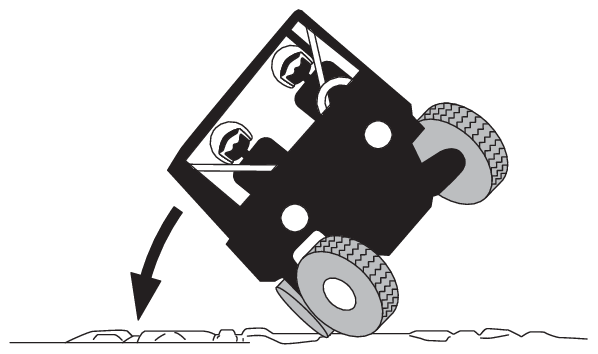SAFETY INFORMATION
Be a responsible owner
As the vehicle’s owner, you are responsible for the safe and proper operation of your Yamaha Wolverine RMAX4. While understanding all parts of this manual are important for vehicle ownership, be sure to read this chapter and the instructions in Chapter 8 before operating your Yamaha Wolverine RMAX4. Also use these two chapters and the labels on the vehicle to instruct new operators and passengers. Do not allow anyone else to operate your vehicle or ride as a passenger if you are unsure that he/she is willing and able to follow these instructions.
Get to know your vehicle
This off-road vehicle will handle and maneuver differently from cars, ATVs, go-carts, golf-cars and grounds-keeping vehicles. Follow these instructions to reduce your risk of an accident and to reduce the risk of serious injury or death in the event of an accident.
Before you operate your Yamaha Wolverine RMAX4
- Prepare yourself and your passengers:
- This vehicle is intended for use only by an operator 16 or older with a valid motor vehicle license. Check local laws for minimum age requirements.

- This vehicle is designed to carry the driver and three passengers. Never carry passengers in the cargo bed.
- The driver and passengers should wear seat belts properly.
- The driver and passengers must be able to put both feet flat on the floorboard while seated upright with their backs against the backrests. The passengers must be able to reach and hold the passenger handhold within the cage/frame.
- The driver and passengers should wear an approved motorcycle helmet that fits properly. The driver and passengers should also wear eye protection (goggles or a face shield), gloves, over-the-ankle boots, long-sleeved shirt or jacket, and long pants.
- Do not drive or ride as a passenger after using drugs or alcohol.
- This vehicle is intended for use only by an operator 16 or older with a valid motor vehicle license. Check local laws for minimum age requirements.
Prepare your vehicle
Perform the pre-operation checks each time you use the vehicle to make sure it is in safe operating condition. Failure to inspect or maintain the vehicle properly increases the possibility of an accident or equipment damage. See page for a list of pre-operation checks.
Prepare your load or trailer
Carrying loads, towing a trailer, or pulling objects can affect handling, stability, and cause the risk of overturns or other accidents.
- Read Chapter 7 before loading, towing, or pulling objects.
- Do not overload the vehicle or trailer. Refer to label in cargo bed for cargo bed load limit. Refer to label next to hitch for tongue weight and trailer load limits.
- Keep weight in the cargo bed centered side to side, and as low and as far forward as possible.
- Secure cargo so that it will not shift – a loose load could change handling unexpectedly or be thrown forward and strike occupants.
While using your Yamaha Wolverine RMAX4
- Keep your body completely inside the vehicle at all times. Keep both hands on the steering wheel. Be sure the passengers are seated, belted, and holding onto the passenger handhold. Close doors before driving. Any part of your body (arms, legs, and head) outside the vehicle can be struck by objects your vehicle is passing or crushed by the vehicle cage/frame in a rollover accident.
- Watch for branches, brush, or other hazards that could enter the vehicle.
- Abrupt maneuvers or aggressive driving, even on flat, open areas, can cause loss of control, including rollovers. The Wolverine RMAX4 has higher ground clearance and other features to handle rugged terrain, and, as a result, can overturn in situations where some other vehicles may not.
- Avoid rollovers:
- Use care when turning:
- Turning the steering wheel too far or too fast can result in a rollover.
- Avoid sideways sliding, skidding, or fishtailing (rear-wheel sliding), and never do donuts.
- Slow down before entering a turn and avoid hard braking in a turn.
- When making tight turns from a stop or at slow speeds, avoid sudden or hard acceleration.

- Drive straight up and down inclines, not across them. If crossing a hill is unavoidable, drive slowly and turn downhill immediately if you feel the vehicle may tip.
- Avoid paved surfaces. Turn gradually and go slowly if you must drive on pavement. This vehicle is designed for off-road use only.
- Use care when turning:
- If you think or feel that the vehicle may tip or roll, keep your body completely inside the protective structure of the vehicle:
- Brace yourself by pressing your feet firmly on the floorboard and keep a firm grip on the steering wheel or passenger handhold.
- Do not put your hands or feet outside of the vehicle for any reason. Your arm or leg could be crushed.
- Do not try to stop a vehicle tipover using your arm or leg.
- Do not operate this vehicle on any public street, road, or highway, even if dirt or gravel.
- Do not operate the vehicle in fast-flowing water or water deeper than 41 cm (16 in). If you must cross shallow, slow-moving water, choose your path carefully to avoid sharp drop-offs, large rocks, or slippery surfaces. Operating this vehicle through deep or fast-flowing water can lead to loss of control or overturn. To reduce your risk of drowning or other injuries, use care when crossing through water.
- When loaded with cargo or towing a trailer:
- Reduce speed, operate in low gear only, and allow more room to stop.
- Avoid hills and rough terrain. Use extreme caution when towing or carrying a load on inclines.
- Load trailer properly and use extra care when towing or pulling.
- Do not tow or pull objects from any part of the vehicle other than the trailer hitch bracket or winch (if installed).
Avoid carbon monoxide poisoning
All engine exhaust contains carbon monoxide, a deadly gas. Breathing carbon monoxide can cause headaches, dizziness, drowsiness, nausea, confusion, and eventually death.
Carbon monoxide is a colorless, odorless, tasteless gas which may be present even if you do not see or smell any engine exhaust. Deadly levels of carbon monoxide can collect rapidly and you can quickly be overcome and unable to save yourself. Also, deadly levels of carbon monoxide can linger for hours or days in enclosed or poorly-ventilated areas. If you experience any symptoms of carbon monoxide poisoning, leave the area immediately, get fresh air, and SEEK MEDICAL TREATMENT.
- Do not run engine indoors. Even if you try to ventilate engine exhaust with fans or open windows and doors, carbon monoxide can rapidly reach dangerous levels.
- Do not run engine in poorly ventilated or partially enclosed areas such as barns, garages, or carports.
- Do not run engine outdoors where engine exhaust can be drawn into a building through openings such as windows and doors.
Genuine Yamaha Accessories
Choosing accessories for your Wolverine RMAX4 is an important decision. Genuine Yamaha Accessories, which are available only from a Yamaha dealer, have been designed, tested, and approved by Yamaha for use on your Wolverine RMAX4.
Many companies with no connection to Yamaha manufacture parts and accessories or offer other modifications for Yamaha vehicles. Yamaha is not in a position to test the products that these aftermarket companies produce. Therefore, Yamaha can neither endorse nor recommend the use of accessories not sold by Yamaha or modifications not specifically recommended by Yamaha, even if sold and installed by a Yamaha dealer.
Aftermarket parts, accessories, and modifications
While you may find aftermarket products similar in design and quality to genuine Yamaha Accessories, recognize that some aftermarket accessories or modifications are not suitable because of potential safety hazards to you or others. Installing aftermarket products or having other modifications performed to your Wolverine RMAX4 that change any of the vehicle’s design or operation characteristics can put you and others at greater risk of serious injury or death. You are responsible for injuries related to changes in the vehicle.
Aftermarket tires and rims
The tires and rims that came with your Wolverine RMAX4 were designed to match the performance capabilities and to provide the best combination of handling, braking, and comfort. Other tires, rims, sizes, and combinations may not be appropriate. Refer to page for tire specifications and more information on replacing your tires.